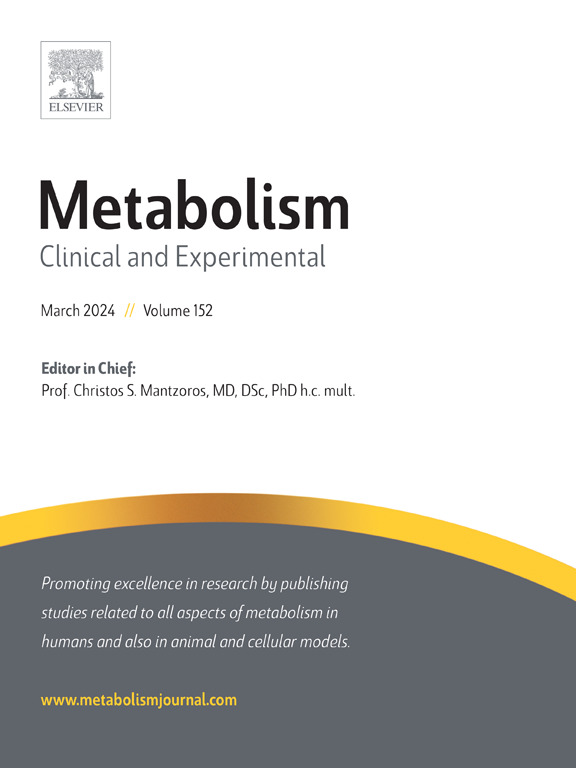BMAL2在肥胖过程中控制脂肪组织炎症和代谢适应。
IF 11.9
1区 医学
Q1 ENDOCRINOLOGY & METABOLISM
引用次数: 0
摘要
当代生活方式的改变,如营养和睡眠/觉醒节律的改变,增加了与肥胖相关的代谢和炎症并发症的风险,包括2型糖尿病(T2D)和代谢功能障碍相关的脂肪性肝炎(MASH)。BMAL2 (Brain and Muscle ARNT Like Protein 2)是一种属于生物钟转录反馈回路的转录因子,它将内部生物节律与环境同步。在人类中,白色脂肪组织(WAT)的表达减少和BMAL2的特定多态性与肥胖和T2D有关。在这项研究中,我们报告了Bmal2缺失导致小鼠在饮食引起的肥胖期间体重增加。BMAL2的缺失通过增加Tnfα表达和改变脂肪细胞祖细胞命运触发炎症反应。这导致WAT内的脂质储存能力降低,并增加肝脏的异位储存。这些功能和结构的改变最终导致肝脂肪变性和胰岛素抵抗的发生。总的来说,我们的研究强调了BMAL2在脂肪细胞的发育和功能中的作用,以及它们在WAT内的炎症潜能。我们的发现有助于理解生物钟基因在肥胖和相互关联的代谢并发症中的作用。本文章由计算机程序翻译,如有差异,请以英文原文为准。

BMAL2 controls adipose tissue inflammation and metabolic adaptation during obesity
Contemporary lifestyle modifications such as changes in nutritional and sleep/wake rhythms increase the risk of metabolic and inflammatory complications linked to obesity, including type 2 diabetes (T2D) and metabolic dysfunction-associated steatohepatitis (MASH). BMAL2 (Brain and Muscle ARNT Like Protein 2) is a transcription factor belonging to the circadian clock transcriptional feedback loop which synchronizes internal biological rhythms to environment. In humans, reduced expression in white adipose tissue (WAT) and specific polymorphisms of BMAL2 are associated with obesity and T2D. In this study we report that Bmal2 deletion in mice leads to increased body weight gain during diet-induced obesity. Loss of BMAL2 triggers the inflammatory response by increasing Tnfα expression and modifying adipocyte progenitor fate. This results in reduced lipid storage capacity within the WAT and increased ectopic storage in the liver. These functional and structural alterations culminate in the onset of hepatic steatosis and insulin resistance in liver and WAT. Overall, our investigations underscore the role of BMAL2 in the development and function of adipocytes, as well as in their inflammatory potential within the WAT. Our findings contribute to the understanding of the role of circadian clock genes in obesity and interconnected metabolic complications.
求助全文
通过发布文献求助,成功后即可免费获取论文全文。
去求助
来源期刊

Metabolism: clinical and experimental
医学-内分泌学与代谢
CiteScore
18.90
自引率
3.10%
发文量
310
审稿时长
16 days
期刊介绍:
Metabolism upholds research excellence by disseminating high-quality original research, reviews, editorials, and commentaries covering all facets of human metabolism.
Consideration for publication in Metabolism extends to studies in humans, animal, and cellular models, with a particular emphasis on work demonstrating strong translational potential.
The journal addresses a range of topics, including:
- Energy Expenditure and Obesity
- Metabolic Syndrome, Prediabetes, and Diabetes
- Nutrition, Exercise, and the Environment
- Genetics and Genomics, Proteomics, and Metabolomics
- Carbohydrate, Lipid, and Protein Metabolism
- Endocrinology and Hypertension
- Mineral and Bone Metabolism
- Cardiovascular Diseases and Malignancies
- Inflammation in metabolism and immunometabolism
 求助内容:
求助内容: 应助结果提醒方式:
应助结果提醒方式:


